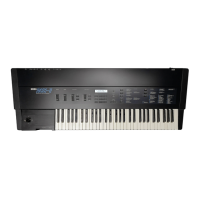L
Floppy Disks and
1| Data structure on DSS-1 floppy disks.
■ The DSS-1 has a built-in floppy disk drive. This is us
ed to store and retrieve your waveform and program
{patch) data from floppy disks.
A single floppy disk can store four "systems," which
are called A, B, C t and D.
In the example in figure 2, you can see how the data
is related and grouped on a single floppy. There is
one set of MIDI parameters (MIDI PRMS). There are
four sets of programs {P01 to P32), one set for each
of the four systems (A through D). Then there are the
muitisounds and sounds. You can store up to about
120 multisounds and sounds, as long as the total
does not exceed the 520,000 data “word” limit (each
of which corresponds to one memory cell).
Programs (the patches numbered P01 to P32) are
stored separately for each system. However, multi
sounds are shared. That isT the same multisound can
be used by any or all of the systems.
In the example, the number 2 multisound (M.SND 02)
is used by ail four of the systems, while multisounds 4
and 6 are used by none.
The individual “sounds“ (that compose the multi
sounds) are not directly linked to the systems. How
ever, the sounds share storage space with the multi-
sounds,
Data Management _
In the diagram, the multisounds (M.SND) that are
marked with an “(a)1' will be loaded into the D S S-V s
memory when you “get“ system A, Likewise, multi
sounds marked with “(b)“, “(c)“, or “(d)“ will be load
ed when you “get“ one of those respective systems.
Below the programs for each system (in the diagram),
is a multisound list (M.SND LIST), This connects the
programs (which are separate for each system) to the
multisounds (which are shared by any systems that
need them). The multisound list is created automati
cally and used when you “save“ or “get“ a system.
As shown in the chart (P. 54), you can save and load in
dividual multisounds, sounds, and other data to and
from the disk, independently of the systems (that is,
without using the “get system“ and "save system“
functions). In such cases, remember that the relation
ships between multisounds and programs (as record
ed in the multisound lists) remain unchanged.
Likewise, if you delete a multisound that is used by a
program (as recorded in the system's multisound
list), then when you later try to use that program
(patch), you will no longer have that multisound as a
sound source.
It is highly recommended that you categorize your
disks. Use some disks for storing your basic sounds.
Use other disks for storing programs and multi
sounds. And use still others for storing and retrieving
your completed systems. This not only makes it
easier to find what you Ye looking for, it also uses disk
storage space most efficiently and provides a degree
of data backup security.
Total may not exceed about 520,000 data words
(about twice the capacity of DSS-1 internal memory).
52

